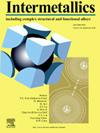探索石墨烯在纳米AlCoCrFeNi高熵合金中的润滑效果
IF 4.8
2区 材料科学
Q2 CHEMISTRY, PHYSICAL
引用次数: 0
摘要
石墨烯/AlCoCrFeNi高熵合金(HEA)复合材料表现出许多卓越的性能,包括增强的机械性能,优越的摩擦和耐磨性,以及出色的热稳定性。然而,石墨烯的润滑机制尚不清楚。在本研究中,我们通过分子动力学(MD)模拟,深入分析了材料在磨损过程中的摩擦力、摩擦系数(COF)、表面损伤、能量变化、温度分布、应力场特征和内部缺陷演变。结果表明,石墨烯涂层显著降低了摩擦力和摩擦曲线的波动,而石墨烯中间层消除了传统的稳定波动阶段,减少了纳米划伤缺陷,并略微降低了径向分布函数(RDF)峰。同时,最大位错深度随划痕距离的增加而减小。温度和晶粒尺寸对涂层- hea的影响最小,但对复合材料- hea的影响很大,特别是界面结合强度在300 K时达到峰值。值得注意的是,复合hea中的层错(SFs)和其他缺陷在高温条件下(1000 K)倾向于重建或湮灭。此外,与(110)和(111)晶面相比,(001)晶面由于其均匀的原子排列,减轻了界面应力集中,进一步降低了COF。这项工作为石墨烯增强HEAs的耐磨机制提供了机理上的见解。本文章由计算机程序翻译,如有差异,请以英文原文为准。
Exploring the lubricating effect of graphene in nano AlCoCrFeNi high-entropy alloy
The graphene/AlCoCrFeNi high-entropy alloy (HEA) composite demonstrated numerous exceptional properties, including enhanced mechanical performance, superior friction and wear resistance, and excellent thermal stability. However, the lubrication mechanism of graphene remains unclear. In this study, we thoroughly analyzed the material's frictional force, coefficient of friction (COF), surface damage, energy variations, temperature distribution, stress field characteristics, and internal defect evolution during the wear process through molecular dynamics (MD) simulations. The results indicate that the graphene coating significantly reduces frictional force and fluctuations in the friction curve, while the graphene interlayer eliminates the traditional stable fluctuation stage, reduces nano-scratch defects, and slightly lowers the radial distribution function (RDF) peak. Concurrently, the maximum dislocation depth decreases with increasing scratch distance. Temperature and grain size exhibit minimal influence on Coating-HEA but substantially affect Composite-HEA, particularly as interfacial bonding strength peaks at 300 K. Notably, stacking faults (SFs) and other defects within Composite-HEA tend to reconstruct or annihilate under high-temperature conditions (1000 K). Furthermore, compared to the (110) and (111) crystallographic planes, the (001) plane mitigates interfacial stress concentration and further reduces the COF owing to its homogeneous atomic arrangement. This work provides mechanistic insights into the wear-resistant mechanisms of graphene-reinforced HEAs.
求助全文
通过发布文献求助,成功后即可免费获取论文全文。
去求助
来源期刊

Intermetallics
工程技术-材料科学:综合
CiteScore
7.80
自引率
9.10%
发文量
291
审稿时长
37 days
期刊介绍:
This journal is a platform for publishing innovative research and overviews for advancing our understanding of the structure, property, and functionality of complex metallic alloys, including intermetallics, metallic glasses, and high entropy alloys.
The journal reports the science and engineering of metallic materials in the following aspects:
Theories and experiments which address the relationship between property and structure in all length scales.
Physical modeling and numerical simulations which provide a comprehensive understanding of experimental observations.
Stimulated methodologies to characterize the structure and chemistry of materials that correlate the properties.
Technological applications resulting from the understanding of property-structure relationship in materials.
Novel and cutting-edge results warranting rapid communication.
The journal also publishes special issues on selected topics and overviews by invitation only.
 求助内容:
求助内容: 应助结果提醒方式:
应助结果提醒方式:


